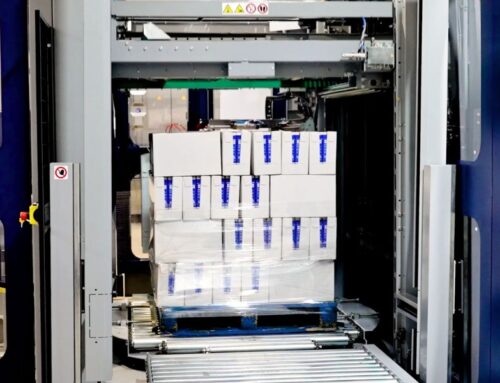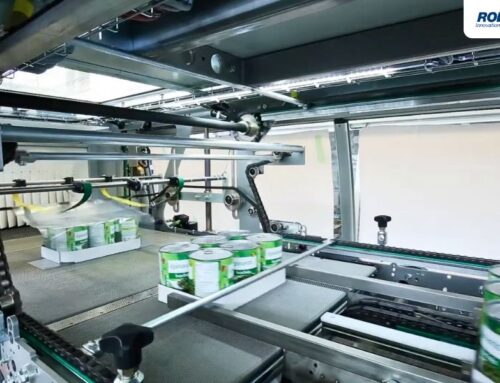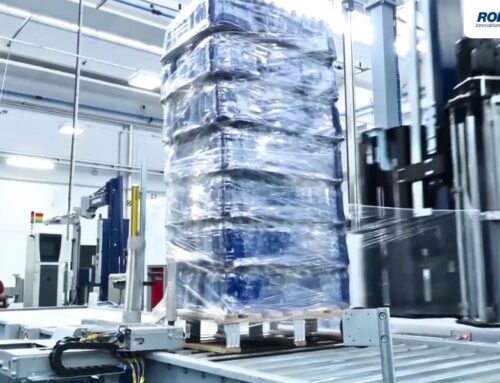A stretch wrapping machine is a fundamental component of any modern packaging and shipping operation, securing goods on pallets to keep them stable and protected during transit. Choosing the right wrapper is a critical business decision, as it directly impacts your bottom line by preventing in-transit damage.
Unlike manual wrapping, a stretch wrap machine wraps loads consistently with precision and reliability, meeting specific standards every time. Below, we’ll show you how to select the right stretch wrapper for your needs by explaining the different types of wrappers, key considerations, and the top features of stretch wrap machines.
Types of Stretch Wrap Machines
When you begin your search for a stretch wrapping machine, you will encounter several different styles. Each type can handle specific load characteristics and operational demands.
Turntable
A turntable stretch wrapper is the most common style of machine. With this design, operators place the pallet load directly onto a turntable that rotates while a film delivery system moves vertically along a mast, applying the stretch film. These machines are versatile and can handle a wide range of applications.
Because the load itself spins, it must be stable enough to withstand the rotational forces, which typically reach speeds of 12 to 15 revolutions per minute. For lighter or more unstable loads, options such as slower rotation speeds or a top platen can hold the load in place during the wrap cycle. Turntable wrappers are also freestanding, offering flexibility in placement.
Rotary Arm
A rotary arm stretch wrapper operates differently. The pallet load remains stationary on the floor while a wrap arm rotates around it to apply the film. This configuration is ideal for loads that are exceptionally heavy, very light, or highly unstable, as it eliminates the centrifugal forces a spinning turntable creates.
If your loads would likely fall apart or shift during rotation, a rotary arm machine is the superior choice. These machines are also suitable for extremely heavy loads, often exceeding the typical 5,000-pound weight capacity of a standard turntable wrapper. Due to the moving arm, they require a larger operational footprint and require anchoring to the floor for safety.
Straddle
Similar to rotary arm wrappers, straddle machines keep the load stationary. Workers place the load on the floor within the wrapping zone, and the machine’s arm, which holds the film delivery system, moves around it. This method is particularly useful for the same types of loads as rotary arm wrappers—very light, unstable, or heavy.
Straddle wrappers tend to take up more floor space than turntable models because of the clearance necessary for the wrapping arm. The decision between a straddle and a turntable often comes down to the characteristics of your loads and the available space in your facility.
Automatic vs. Semi-Automatic Machines
Within stretch wrappers, there are two major categories: automatic and semi-automatic machines. Semi-automatic machines require an operator to place the load, attach the film, and start the wrapping cycle. Once the cycle is complete, the operator cuts the film and removes the pallet. These machines are an economical choice for low-volume applications.
Automatic stretch wrappers are fully automated systems that integrate into a production line. They handle the entire process without manual intervention, from conveying the pallet into the wrap zone to attaching, wrapping, cutting the film, and moving the load downstream. These machines offer high speed and efficiency, making them the right investment for large-scale packaging operations with high throughput demands.
Key Considerations When Selecting a Stretch Wrapper
Now that you understand the types of stretch wrappers, how do you select the right one for your needs? To find the ideal machine for your environment and process, you’ll have to consider the characteristics of the loads you’ll be wrapping, wrapping volume, and more.
Load Stability and Weight
The characteristics of your pallet loads are the most critical factor. Consider the stability and weight of your typical loads. Rotary-arm or straddle wrappers generally suit very heavy, very light, or unstable loads, as they keep the pallet stationary.
A turntable machine is best for efficiently wrapping loads of moderate weight. If you have various load types, you might need a machine with adjustable settings or features like a top platen to accommodate different requirements.
Wrapping Volume
Your daily wrapping volume is another essential consideration. How many loads do you wrap per day or per hour? Low-volume operations might find a semi-automatic machine to be a cost-effective solution.
For high-volume environments, an automatic stretch wrapper will significantly increase throughput and reduce labor costs. Consider your current needs and anticipate future growth to ensure the machine you purchase can scale with your business.
Film Type and Pre-Stretch
The type of stretch film you use and the machine’s pre-stretch capabilities have a major impact on material costs. Powered pre-stretch film delivery systems can reduce film costs substantially in comparison to hand wrapping. These systems stretch the film before applying it to the load, maximizing its yield and strength.
Higher pre-stretch percentages mean greater film savings, which are substantial for companies wrapping a high number of loads. Ensure the machine you choose is compatible with the film you plan to use and offers the pre-stretch level that provides the best balance of cost savings and load containment.
Top Stretch Wrapper Features
Modern stretch wrapping machines feature a range of features to improve efficiency, reliability, and film usage. Focusing on these key attributes will help you select a machine that delivers consistent, high-quality results.
Consistent Wrapping
The primary goal of a stretch wrap machine is to apply film consistently to create a safe-to-ship load. This consistency comes from having precise control over containment force—the combination of film tension and the number of film layers. The machine should allow you to set and maintain the correct containment force for the top, middle, and bottom of the load. Effective load containment prevents products from shifting during transit, which causes shipping damage.
Reliable Operation
A reliable stretch wrapping machine is one that operates with minimal downtime. Look for machines with durable components that require low maintenance. For example, some machines use belts instead of chains, which require less lubrication and are quieter.
A manufacturer with a large customer base and a history of life-cycle testing its components is a good indicator of reliability. The machine should be strong enough to withstand the demands of your specific industrial environment.
Efficient Film Usage
A high-performance film delivery system can significantly stretch the film, reducing the amount necessary per load. This lowers material costs and contributes to sustainability goals by reducing plastic waste. Some advanced machines also feature automatic film cut-and-clamp systems, which eliminate long, dragging film tails that can get caught in downstream equipment and compromise the load’s integrity.
Find Your Ideal Solution at Robopac USA
Finding the ideal stretch wrapping machine is key to improving operational efficiency, reducing costs, and protecting your products. By assessing your load characteristics, wrapping volume, and specific needs, you can find the ideal machine, whether it’s a turntable wrapper for stable loads or a rotary arm system for tougher applications.
A reliable, efficient machine with consistent wrapping and optimal film usage will deliver long-term benefits. If you’re ready to upgrade your packaging operations, contact Robopac USA to find the perfect stretch wrapping solution for your business.








